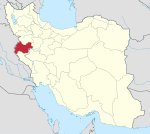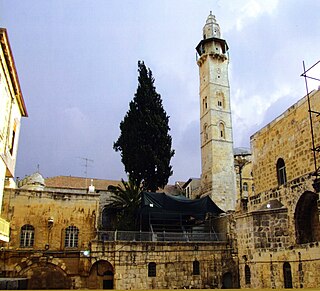
The Ayyubid Mosque of Omar is an Islamic place of worship inside the Old City of Jerusalem. It is located opposite the southern courtyard of the Church of the Holy Sepulchre, in the Muristan area of the Christian Quarter. The mosque is not open to tourists, and can be accessed only for praying.
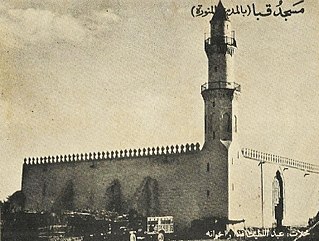
The Quba Mosque is a mosque located in Medina, in the Hejazi region of Saudi Arabia, built in the lifetime of the Islamic prophet Muhammad in the 7th century C.E. It is thought to be the first mosque in the world, built on the first day of Muhammad's emigration to Medina. Its first stone is said to have been laid by the prophet, and the structure completed by his companions.
Najib ad-Din Abu Hamid Muhammad ibn Ali ibn Umar Samarqandi was a 13th-century Persian physician from Samarqand.
Al-Miqdad ibn Amr al-Bahrani, better known as al-Miqdad ibn al-Aswad al-Kindi or simply Miqdad, was one of the companions of the Islamic prophet Muhammad. His kunya was Abu Ma'bad. Miqdad was born in Eastern Arabia. He became fugitive in his hometown and ran to Mecca, where he served Aswad al-Kindi. Miqdad managed to gain favor of his master, who in turn adopted him as his son.
ʿUmar ibn Saʿd ibn Abi Waqqas was a son of prophet Muhammad's companion, Sa'd ibn Abi Waqqas. He was born in Medina and later moved to Kufa, which was founded by his father and stayed there until his death.
Ali ibn Umar was the seventh Idrisid ruler of Morocco.
Qadial-Aqib ibn Mahmud ibn Umar ibn Muhammad Aqit was a Sanhaja Berber qadi of Timbuktu and Imam of Sankore mosque.
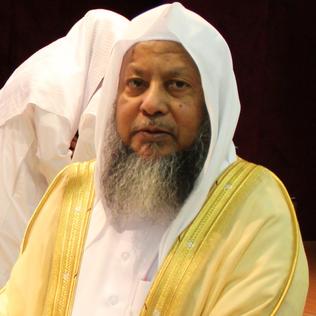
Muhammad Ayyub ibn Muhammad Yusuf ibn Sulaiman `Umar was a Saudi Arabian Imam, Qari, and Islamic scholar known for his recitation of the Quran. He was an Imam of Al-Masjid an-Nabawi in Medina, Saudi Arabia. He was also a faculty member of the Department of Tafsir in the Faculty of the Holy Qur'an and Islamic Studies at the Islamic University of Madinah and a member of the Scholarly Committee of the King Fahd Complex for the Printing of the Holy Quran. His death occurred on 16 April 2016.
The Al Farooq Omar Bin Al Khattab Mosque is a mosque located in Dubai, United Arab Emirates. The mosque is named after Umar bin Al Khattab, a companion of the Prophet Mohammed who became the second Caliph after Abu Bakr and was given the title Al Farooq, meaning someone who distinguished truth from falsehood. The original Al Farooq Omar Bin Al Khattab Mosque was established on the same site in 1986.
Al‐Malik Al‐Ashraf Umar Ibn Yūsuf Ibn Umar Ibn Alī Ibn Rasul, known as Umar Ibn Yusuf was the third Rasulid sultan, who ruled as Al-Ashraf Umar II. He was also a mathematician, astronomer and physician.
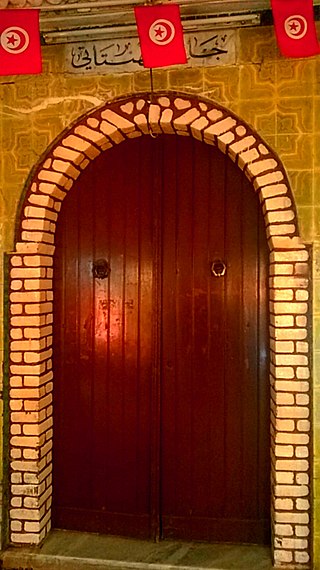
El Hentati Mosque ' is a small mosque in the west of the medina of Tunis, in souk El Leffa.

Al-Muhdar Mosque or Al-Mihdar Mosque is one of the historical mosques in the ancient city of Tarim, in the Yemeni province of Hadramaut. It is attributed to Omar Al-Mihdar bin Abdul-Rahman Al-Saqqaf, a Muslim leader who lived in the city during the 15th-century.
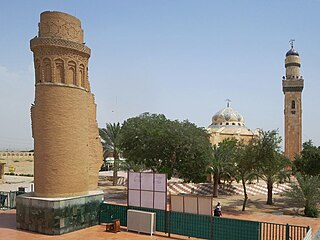
The Imam Ali Mosque or the Old Mosque of Basra is the first mosque built in Basra, Iraq and among the oldest mosques in the history of Islam.
Abu Umar Muhammad ibn Yusuf al-Kindi was a prominent Arab historian, genealogist, and hadith scholar. He studied under the most famous hadith scholar of his time, imam al-Nasa'i.
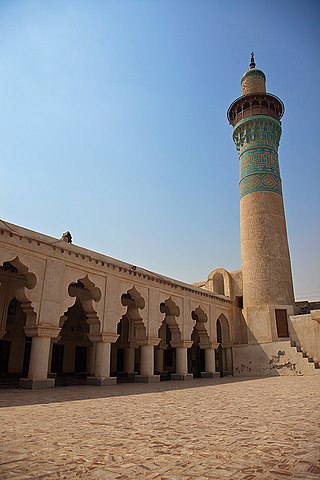
The Malek bin Abbas Mosque dates from the Timurid Empire and is located in Hormozgan Province, Bandar Lengeh.
Abu Salih as-Samman was an early Islamic scholar of Medinah. He was a narrator of Hadith is among the Tabi'un generation of Muslims.
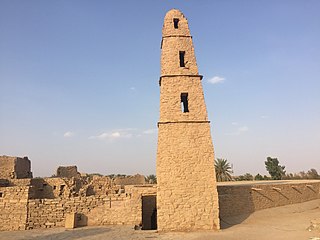
The Mosque of Umar Ibn al-Khattab is a historic mosque in Dumat al-Jandal in northern Saudi Arabia, located adjacent to the Marid Castle. It is one of the oldest mosques in the north of the Arabian Peninsula and is considered one of the important monuments in Al-Jawf and in Saudi Arabia in general.
Ahmad ibn Umar al-Hazimi is a Saudi scholar whose interpretation of takfir (excommunication) gave rise to the eponymous Hazimi branch of Wahhabism. A relatively unknown figure until he publicised his teachings in Tunisia after the 2011 revolution, followers of al-Hazimi's views briefly wielded considerable power within the Islamic State of Iraq and the Levant (ISIS). He was arrested and imprisoned by Saudi authorities in 2015.
Ahmad ibn Ishaq Ash'ari Qomi was one of the most trusted hadith narrators of the Shiites. He is said to have been a delegate from Qom to al-Askari. It is also said that al-Hadi paid Ahmad's debts worth thirty-thousand dinars. He met the last four Shiite Imams and was one of their companions and the agent of the 11th Shiite Imam.
Nafi bin Sarjis Abu Abdullah ad-Dailami, also known as Nafi` Mawla ibn `Umar, was a scholar of Fiqh jurisprudence and muhaddith from the Tabiun generation who resided in Medina.
























